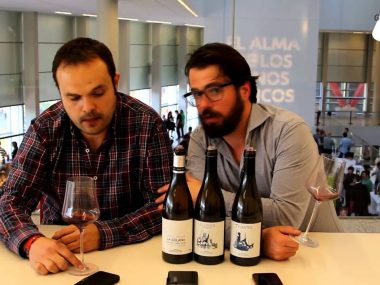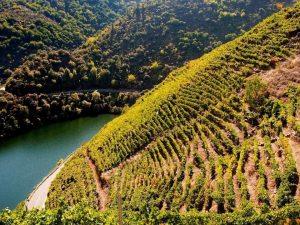Volcanic wines are exclusive and highly valued, due to their high quality, as the grapes are grown on very mineral soils. These wines are produced in very specific areas of the world and differ considerably from wines produced in other regions.
One of the main characteristics of these wines is that the soils where the vines are grown have a high oxygen content, are very rich in micronutrients, and that erosion, as well as the action of bacteria, fungi and other microorganisms, provide them with a large amount of nutrients.
Another relevant aspect is that these soils are inhospitable to phylloxera, so the vineyards are not affected by this plague that damages the vines.
On the other hand, rocks and volcanic soils have a high percentage of porosity, so they retain water better and the grapes make better use of the minerals in the soil.
For example, on the coast of Sicily in Italy, there is one of the most imposing volcanoes in Europe, the volcano Etna. In this area, organic viticulture is practised and some of the best volcanic wines are produced.
Tokaj in Hungary produces what were once known as the wines of kings, and here there are wine cellars that are carved out of volcanic rock.
Similarly, in the Canary Islands in Spain, volcanic wine is also produced, thanks to the fact that in this area there are soils covered with layers of volcanic lapilli, due to the eruption of the Timanfaya volcano that took place between 1730 and 1736. In fact, there are still old vineyards covered by volcanic ash.
Lanzarote, the paradise of volcanic wines
Lanzarote is an island belonging to the archipelago of the Canary Islands. It has a sub-desert climate due to its location, which is very close to the African continent, from where warm winds from the Sahara arrive from time to time. Rainfall is scarce and temperatures are high, although the Atlantic Ocean exerts a thermoregulatory effect.
The soil of Lanzarote is volcanic. While in the centre of the island the thickness of the volcanic layer can be up to two metres deep, in the north it is no more than 30 centimetres. The volcanic ash acts like a sponge to retain moisture from the ocean, which condenses thanks to the action of the trade winds. This greatly benefits the crops.
The Designation of Origin (D.O.) of Lanzarote was created in 1993 and covers the entire surface of the island, while the total cultivation area covers some 1,900 hectares.
The wines produced in Lanzarote are recognised worldwide as they are different from all other wines because of their flavour, body, minerality and even their aroma.
Moreover, there is a world-renowned wine route on the island. Wine tourism has aroused the interest of both locals and visitors, who want to get to know the characteristics of the best wines of the area, which are also known as the best wines in the world.
On this wine route you can visit several wineries in the area, one of the most important of which is the Puro Rofe winery, which we will talk about later.
The challenges of viticulture in Lanzarote
Lanzarote presents enormous challenges for winegrowers. Deep pits have to be dug in a soil completely covered by volcanic ash, which was formed after the eruptions that covered almost a third of the island in 1730 and 1736, and they have to dig as deep as necessary until they reach the topsoil.
In this way, the vines are protected from the wind, the humidity is harnessed and evaporation is prevented. In addition, semicircular stone walls are built to protect the vines from the powerful trade winds.
Another type of cultivation that is traditional in Lanzarote due to its conditions is the chaboco. The lava flow produced cracks in the area, and in these cracks, vine growers planted grape varieties such as Muscat of Alexandria. These centuries-old vines were dug by hand. Although the yield per vine is admittedly low, the few vines that manage to thrive are of very high quality.
Several varieties of grapes are grown on the island, the main ones being the volcanic malvasia, which is different from that of the islands of La Palma or Tenerife, the listán negra, listán blanca, moscatel and Diego or vijariego. With this diversity of grapes, white, rosé and red wines can be obtained; dry, sweet and semi-sweet sparkling wines.
Puro Rofe Winery
The Puro Rofe winery produces some of the best volcanic wines, which have been recognised nationally and internationally; in fact one of the most influential wine critics in the world wrote a positive review about this winery, which made it even more popular.
This winery was founded in 2017. It was created by an agreement between local winegrowers and foreign winegrowers, some of them are Vicente Torres, Ascensión Robaina and Pedro Umpierrez. Rayco Fernández, Dirk Niepoort, Raúl Pérez and Carmelo Peña are also part of the group, being Vicente Torres the one who invited the other winegrowers to take part in this project. He learned how to take care of the vineyards from his father-in-law César Rodríguez Cabrera.
Back to tradition
This winery practices natural and organic wine production, respecting the environment and using traditional and artisanal methods with minimal intervention, avoiding the use of harmful chemicals.
Although this type of agriculture is much more difficult and strenuous, it allows the best grapes to be obtained and therefore, with them, wines of excellent quality can be produced. It is also environmentally friendly and sustainable.
It is important to bear in mind that the creators of this project try to cultivate the vines by zones, and that in each zone the characteristics of the land and the climate are very different, which means that the characteristics of each grape and therefore of the wines can be very different.
In this sense, the vineyards are cultivated in areas such as La Geria, Masdache, Montaña La Vieja and Tisalaya, which, as we have already explained, is due to the fact that the characteristics of each grape and the conditions they need to develop best are taken into account.
Harvesting is done by hand when the grapes reach optimum ripeness, and only the highest quality grapes are selected. The grapes are crushed before pressing. Afterwards, spontaneous fermentation takes place with indigenous yeasts, and the wines are aged in barrels or stainless steel tanks.
The first wine produced in this winery was a white wine made from volcanic malvasia, which was sold only to the United States.
Despite its short time in operation, this winery has already positioned and consolidated itself in the national and international market, becoming a reference in the production of volcanic wines.
Puro Rofe White 2021
This white wine is produced by the Puro Rofe winery with Malvasía, Listán Blanco and Vijariego Blanco grape varieties, which are planted in pits about three metres deep. The ageing process lasts about eight months in stainless steel tanks.
The Rofe Blanco wine stands out for its fruity flavour, with a balanced acidity and herbal notes as well as white fruits. It is a very mineral, light and fresh wine, quite elegant, perfect to pair with fish, seafood and salads.
Puro Rofe Mentidero 2021
The volcanic wine Puro Rofe Mentidero is partly aged in oak barrels and partly in stainless steel tanks. It is then bottled without filtering or stabilisation.
It is a fresh wine with a fruity flavour and saline touches, which goes perfectly with meats and white cheeses.
Puro Rofe Masdache 2021
The white wine Puro Rofe Masdache is made with three varieties of native vines from Lanzarote, such as Malvasia Volcanica, Vijariego Blanco and Listán Blanco.
It is a wine aged for seven months in stainless steel tanks, which has a marked minerality, a saline touch and a fruity flavour with aromas of white fruits. It is highly recommended to accompany white fish and seafood.






